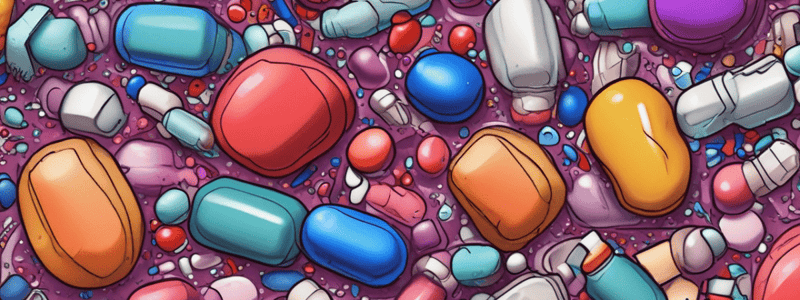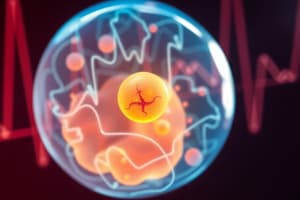Podcast
Questions and Answers
What is the primary action of Class I anti-dysrhythmic drugs?
What is the primary action of Class I anti-dysrhythmic drugs?
- Potassium channel blockers
- Beta blockers
- Calcium channel blockers
- Sodium channel blockers (correct)
Amiodarone is only approved for life-threatening __________ dysrhythmias.
Amiodarone is only approved for life-threatening __________ dysrhythmias.
ventricular
What is a common side effect of Quinidine?
What is a common side effect of Quinidine?
Cinchonism
Class II agents include sodium channel blockers.
Class II agents include sodium channel blockers.
Which drug can double digoxin levels?
Which drug can double digoxin levels?
What is the treatment of choice for ventricular dysrhythmias?
What is the treatment of choice for ventricular dysrhythmias?
Which of the following are indications for the use of Mexiletine?
Which of the following are indications for the use of Mexiletine?
Calcium channel blockers are used for atrial fibrillation.
Calcium channel blockers are used for atrial fibrillation.
What are common side effects of Class II beta blockers?
What are common side effects of Class II beta blockers?
Digoxin decreases conduction in the AV node and prolongs the __________ interval.
Digoxin decreases conduction in the AV node and prolongs the __________ interval.
Which medication is used for cardioversion that can be administered IV?
Which medication is used for cardioversion that can be administered IV?
Flashcards are hidden until you start studying
Study Notes
Anti-Dysrhythmic Drugs
Class I: Sodium Channel Blockers
- Divided into three subcategories: IA, IB, and IC
- IA: Quinidine, slows impulse conduction in atria, ventricles, and Purkinje fibers
- IA: Quinidine, delays repolarization, suppresses dysrhythmias, widens QRS and prolongs QT interval
- IA: Quinidine, active against supraventricular and ventricular dysrhythmias, indicated for long-term suppression
- IA: Quinidine, adverse effects include cinchonism, cardiotoxicity, and can double digoxin levels
- IB: Mexiletine, oral analogue of lidocaine, used for symptomatic ventricular dysrhythmias
- IB: Mexiletine, eliminated by hepatic metabolism, prolonged effects in liver patients, adverse effects include GI, neurologic, and can exacerbate HF
- IC: Flecainide and propafenone
Class II: Beta Blockers (BB)
- Examples include propranolol, acebutolol, esmolol, and sotalol
- Prolong QT, decrease Ca entry, and can cause HF, AV block, sinus arrest, hypotension, and bronchospasm
Class III: Potassium Channel Blockers
- Example: Amiodarone, used for life-threatening ventricular dysrhythmias, atrial and ventricular dysrhythmias
- Amiodarone, toxicity can continue for weeks-months after discontinuation, requires medication guide
- Amiodarone, adverse effects include pulmonary toxicity, liver toxicity, thyroid toxicity, and requires regular monitoring of CXR, TSH, and LFTs
- Amiodarone, widens QRS and prolongs QT and PR
Class IV: Calcium Channel Blockers (CCB)
- Examples include verapamil and diltiazem
- Used for afib or flutter, and SVT, adverse effects include bradycardia, AV block, HF, hypotension, peripheral edema, and constipation
- Elevate digoxin levels, can cause bradycardia, AV block, and HF when given with BB
Others
- Adenosine, digoxin, and ibutilide
- Digoxin, decreases conduction in AV, prolongs PR interval, and decreases automaticity in SA
- Digoxin, used only for supraventricular dysrhythmias, risk increased with hypokalemia
Studying That Suits You
Use AI to generate personalized quizzes and flashcards to suit your learning preferences.




